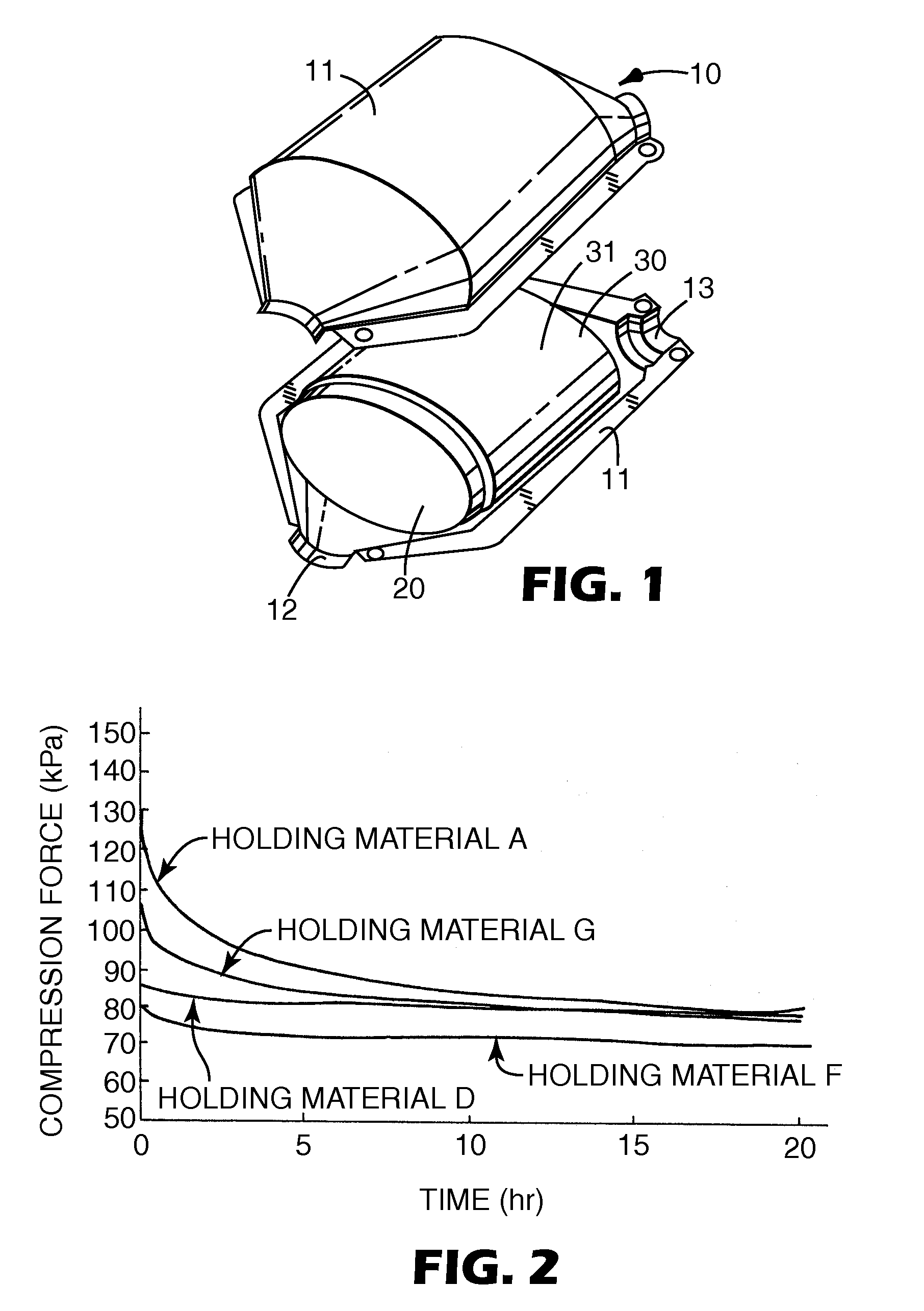Catalyst carrier holding material and catalytic converter
a technology of catalytic converter and carrier, which is applied in the direction of combination devices, machines/engines, chemical/physical processes, etc., can solve the problems of material not being able to withstand extended use, deterioration of fibers, and inability to apply insulation materials such as those disclosed in the aforementioned unexamined patent publications for operating temperatures in such high ranges
- Summary
- Abstract
- Description
- Claims
- Application Information
AI Technical Summary
Benefits of technology
Problems solved by technology
Method used
Image
Examples
example 1
Manufacture of Catalyst Carrier Holding Materials (Mats)
[0051]The following seven different mat-shaped catalyst carrier holding materials were manufactured using inorganic fibers composed of or comprising the two components alumina and silica, having an alumina / silica mixing ratio of 72:28 and different mullite ratios (2%, 35%, 60%, 70% and 78%).
[0052]For manufacture of each of the holding materials, first the inorganic fibers (a mixture of two different inorganic fibers for manufacture of holding material G) and the organic binder (trade name: “LX-816”) (flocculating agent) were placed in water, and the fibers were opened and mixed. Next, the mixture was gently stirred to prepare a slurry. The slurry was then sheeted and molded into the desired mat shape. The molded product was squeezed to remove the excess moisture, and then the mat was pressed while heating to dryness at the prescribed temperature. This yielded the following catalyst carrier holding materials each having a thickn...
example 2
[0070]The desirable properties experienced with the present invention can be obtained from a mat made by blending low mullite content fiber (e.g., less than 10%) and high mullite content fiber (e.g., greater than 70%). Such properties can also be obtained, for example, with a layered mat, using low mullite content fibers for at least one layer and high mullite content fibers for at least one other layer.
[0071]Sample mat-shaped catalyst carrier holding materials were made as described for Example 1 above with 2% and 78% mullite content fibers. Fiber blend ratios and layering ratios were figured as average mullite % calculated by fiber weight and its fiber % mullite. For example, the average mullite % of a mat made of a 50 / 50 blend of these mullite fibers (i.e., 2% and 78% mullite content fibers) is 40%. Compression at 900 deg.C. and erosion resistance were evaluated and results were summarized below in Table 2.
Inclination is b in approximated equation: Y=aXb
[0072]
TABLE 2InclinationEx...
PUM
| Property | Measurement | Unit |
|---|---|---|
| operating temperatures | aaaaa | aaaaa |
| length | aaaaa | aaaaa |
| length | aaaaa | aaaaa |
Abstract
Description
Claims
Application Information
 Login to View More
Login to View More - R&D
- Intellectual Property
- Life Sciences
- Materials
- Tech Scout
- Unparalleled Data Quality
- Higher Quality Content
- 60% Fewer Hallucinations
Browse by: Latest US Patents, China's latest patents, Technical Efficacy Thesaurus, Application Domain, Technology Topic, Popular Technical Reports.
© 2025 PatSnap. All rights reserved.Legal|Privacy policy|Modern Slavery Act Transparency Statement|Sitemap|About US| Contact US: help@patsnap.com


